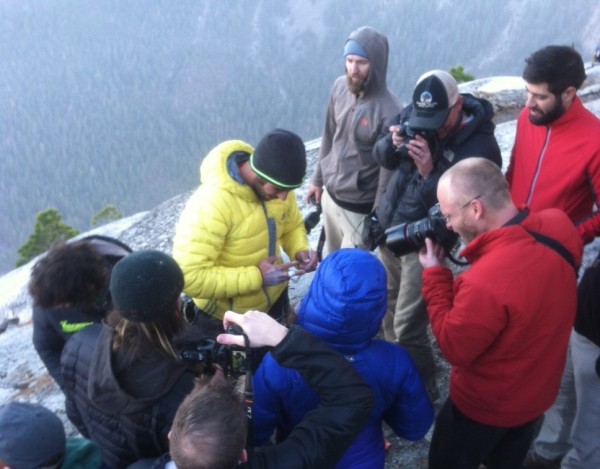
Photographers surround Kevin Jorgeson and Tommy Caldwell on El Capitan. (Matt Brown/ The Press Democrat
Most reporters chose to cover the Yosemite climbers from below. But reporter Matt Brown hiked some 9 miles and 3,000 vertical feet to capture the story. Here is his behind the scenes look at the hike to the top.
At 4 a.m., it was 25 degrees in Yosemite Valley. No telling how cold it would be on the rim of the Valley, but I would hopefully find out soon.
This was no ordinary, leisurely hike. I had a deadline. My goal was to reach the top of El Capitan, some 9 miles and 3,000 vertical feet distant, in time to catch two of the most famous rock climbers pull atop the Dawn Wall climbing route and into history. I heard they could top out any time after 10 a.m. I had to hustle.
There is no easy route to the top of El Cap. The least difficult involves hiking to the top of Yosemite Falls, itself a 3.6-mile uphill slog, and then navigating the five-mile trail along the rim of Yosemite Valley. It was dark when I set out, though the light from a quarter moon was enough to see the trail, allowing me to save headlamp batteries.
The lower 30 switchbacks are rocky and buried under a canopy of oak trees. After about 1.5 miles, the trail emerges from the trees and skirts a narrow ledge about 1,500 feet up the side of the Valley. This part of the trail affords beautiful views of the tops of the majestic Ponderosa pines on the Valley floor and Half Dome, posted like a sentinel guarding the eastern entrance to the Valley.
I hit this spot at 5 a.m., still dark, and had a unique view of the Valley walls in the moon light and flickers from campers just waking up down below. Though it was still below freezing, the hike warmed me up and I shed my down jacket.
Rounding a corner, I could hear for the first time the roar from Upper Yosemite Falls. Recent rains have recharged all of Yosemite’s waterfalls, and I could feel the icy spray from the falls as I picked my way up the upper switchbacks to the top of the Valley.
I reached the top just as the pale light of dawn illuminated the landscape and I could see in detail for the first time. To the right, the trail led to the top of Yosemite Falls proper. Straight ahead, I could see that the path to the summit of El Cap was covered in two feet of snow. Though the trail was flatter, the icy expanse made walking without crampons (I had none) treacherous, and I was forced to take it slow. The cold made my legs cramp up, and I had to stop and stretch frequently.
The trail wound up and down small peaks and valleys, through pine forests and across football field-sized patches of granite. I came out of a strand of trees and into the direct sunlight for the first time. The warmth felt wonderful. At 8 a.m., I met the first people I had seen on the trail, a photographer and reporter for the New York Times. They started the hike an hour earlier than me, and I felt good having passed them.
By 9 a.m., I reached the summit of El Cap, marked by a large cairn or rock pile. I was tired but also excited to hopefully find the two rock climbers, Tommy Caldwell and Kevin Jorgeson, near the top of their historic climb. After some scrambling around, I located the spot where they would likely emerge from their climb. A crowd had already started to gather. A crew from Patagonia, Caldwell’s sponsor, was setting up to capture the moment. Other news outlets, including NBC and ABC, had camped on top and were also waiting for the money shot.
We waited and received updates from a film crew with the climbers below. Friends and family of the climbers began arriving in anticipation of their accomplishment. I hung out with a contingent of a dozen Sonoma County climbers who came to cheer on Jorgeson, our hometown boy. From a promontory of rock jutting out over the face of El Cap, we had a good view of the climbers on the upper reaches of the wall and could monitor their progress.
Finally, as the afternoon wore on, it looked as if they were about to reach the top. At 3:30 p.m., the two emerged, grizzled and weathered from 19 days on the wall. They hugged family members and popped champagne bottles while cameras captured every move.
After an hour covering the celebration, I started down with the first wave of the roughly 40 people who were on the summit. Instead of walking the 9 miles back down the trail, I chose to use a trail frequented by climbers called the East Ledges Descent. This way involves some tricky route-finding, scrambling and 600 feet of rappelling.
Having anticipated this route, I brought some rappelling gear.
I followed a couple climbers down the steep slabs on the rim of El Cap to the easternmost edge where the fixed ropes begin. Then I harnessed up, stepped over the precipice and rappelled down to the Valley below. Within an hour, I was back among the oak and manzanita. A few steep switchbacks on a climber’s trail put me out into the meadow at the base of El Cap and back into civilization. It took an hour and a half to descend the mountain that took five hours to climb.
Emerging from the woods at a parking lot at dusk, I was greeted by a throng of journalists and photographers who, being less intrepid, chose to cover the climb from the Valley below. They all wanted to know when the men-of-the-hour would be coming down. I pointed to the line of headlamps high up on the wall above and said that they were among the group making their way down. I didn’t wait around. I needed a hot shower, and a cold beer.
–Staff Writer Matt Brown.
Read Matt’s story here.
- A hiker pauses to catch a glimpse of Half Dome. (Matt Brown/ The Press Democrat)
- A trail sign surrounded by snow on El Capitan. (Matt Brown/ The Press Democrat
- A view of Half Dome from the trail. (Matt Brown/ The Press Democrat)
- Hikers watch the historic ascent from the trail. (Matt Brown/ The Press Democrat)
- Hikers watch the historic ascent from the trail. (Matt Brown/ The Press Democrat)
- Jorgeson and Caldwell surrounded by a a throng of photographers on El Capitan. (Matt Brown/ The Press Democrat)

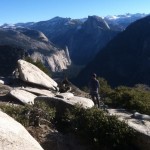
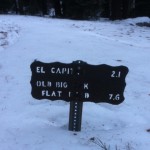
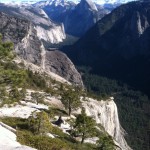
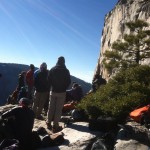
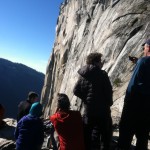
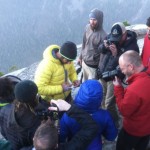
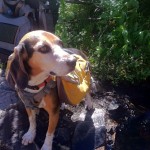 , New York native, I spent half of my life hibernating indoors, but for the past five years I have basked in the thrilling opportunity to enjoy year round hiking on the many trails of beautiful Northern California. In this blog I will continue in the tradition of trailhead, to recap the hikes I have taken and share the insights of my fellow hikers. Along with day hikes, I am also interested in dog friendly trails, and backpacking trips as well. Please feel free to offer suggestions of where I should hike next, or share tales of where you have explored. . Guest blog entries are extremely welcome as are your photos from your own hikes.
, New York native, I spent half of my life hibernating indoors, but for the past five years I have basked in the thrilling opportunity to enjoy year round hiking on the many trails of beautiful Northern California. In this blog I will continue in the tradition of trailhead, to recap the hikes I have taken and share the insights of my fellow hikers. Along with day hikes, I am also interested in dog friendly trails, and backpacking trips as well. Please feel free to offer suggestions of where I should hike next, or share tales of where you have explored. . Guest blog entries are extremely welcome as are your photos from your own hikes.